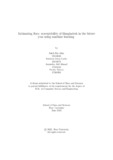| dc.contributor.advisor | Islam, MD Saiful | |
| dc.contributor.advisor | Syed, Shehran | |
| dc.contributor.advisor | Anik, Marum Monem | |
| dc.contributor.author | Alim, Sakib Bin | |
| dc.contributor.author | Lucky, Rakebun Islam | |
| dc.contributor.author | Ahmed, Aunindya Arif | |
| dc.contributor.author | Nahian, Prethu | |
| dc.date.accessioned | 2021-10-11T04:36:17Z | |
| dc.date.available | 2021-10-11T04:36:17Z | |
| dc.date.copyright | 2021 | |
| dc.date.issued | 2021-06 | |
| dc.identifier.other | ID 21141068 | |
| dc.identifier.other | ID 21141071 | |
| dc.identifier.other | ID 17101225 | |
| dc.identifier.other | ID 17301191 | |
| dc.identifier.uri | http://hdl.handle.net/10361/15202 | |
| dc.description | This thesis is submitted in partial fulfillment of the requirements for the degree of Bachelor of Science in Computer Science and Engineering, 2021. | en_US |
| dc.description | Cataloged from PDF version of thesis. | |
| dc.description | Includes bibliographical references (page 29-30). | |
| dc.description.abstract | Being a riverine country with more than 400 rivers, flood is a common phenomenon
for Bangladesh. As, the land is less than five meters above sea level, and also
due to heavy rainfall during monsoon season, it makes the country an easy target
of flooding and about 30% of the total area is in danger level during this period.
Additional to the yearly flooding, every 4 to 5 years there is a major flood occurs
which covers more than 60% of the country. As of 22 July, 2020 alone, 102 upazila
and 654 unions have been inundated in flood, affecting 3.3 million people, leaving
731,958 people water logged and a total of 93 deaths [2]. The aim of this research
is to predict Bangladesh’s susceptibility to flooding so that the government as well
as the people of this country can take necessary steps to lessen the effect. To
predict the probability of flood we will be using some machine learning algorithm
namely Linear Regression model, Random forest Regressor, Naive Bayes Theorem
and Artificial Neural Network. This study is based on the data set from 1991-2013
water level and weather variables from Khulna districts Rupsa-Pasur station. | en_US |
| dc.description.statementofresponsibility | Sakib Bin Alim | |
| dc.description.statementofresponsibility | Rakebun Islam Lucky | |
| dc.description.statementofresponsibility | Aunindya Arif Ahmed | |
| dc.description.statementofresponsibility | Prethu Nahian | |
| dc.format.extent | 30 pages | |
| dc.language.iso | en | en_US |
| dc.publisher | Brac University | en_US |
| dc.rights | Brac University theses are protected by copyright. They may be viewed from this source for any purpose, but reproduction or distribution in any format is prohibited without written permission. | |
| dc.subject | Flood Susceptibility | en_US |
| dc.subject | Machine Learning | en_US |
| dc.subject | Flood in Bangladesh | en_US |
| dc.subject | Linear Regression Model and Random forest | en_US |
| dc.subject | Naive Bayes Theorem | en_US |
| dc.subject | Artificial Neural Network | en_US |
| dc.subject.lcsh | Machine Learning | |
| dc.title | Estimating flood susceptibility of Bangladesh in the future year using machine learning | en_US |
| dc.type | Thesis | en_US |
| dc.contributor.department | Department of Computer Science and Engineering, Brac University | |
| dc.description.degree | B. Computer Science | |

